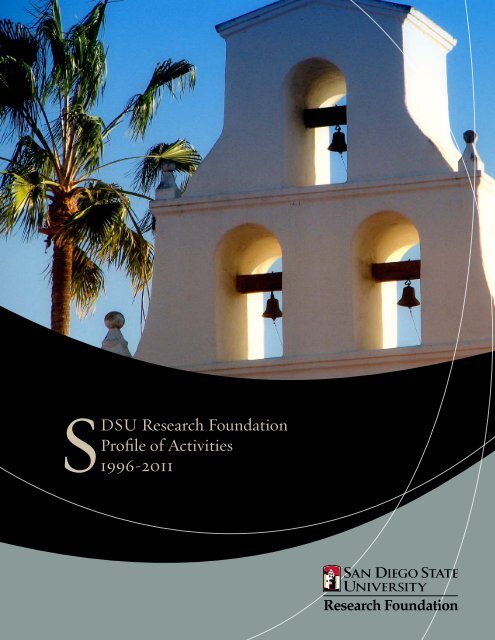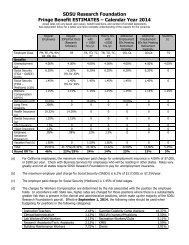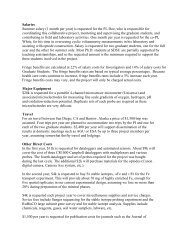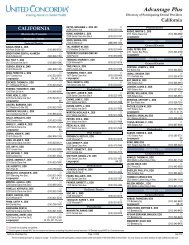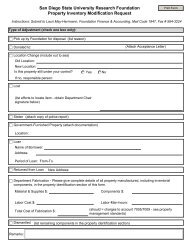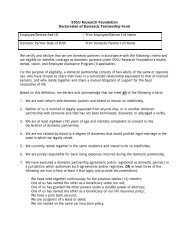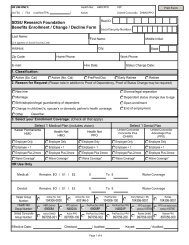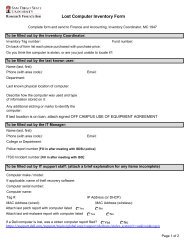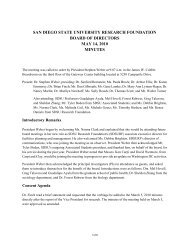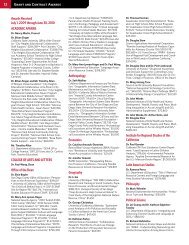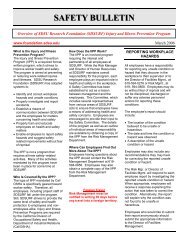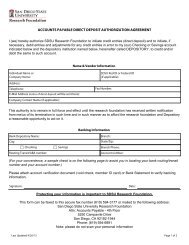RF Profile of Activities - SDSU Research Foundation - San Diego ...
RF Profile of Activities - SDSU Research Foundation - San Diego ...
RF Profile of Activities - SDSU Research Foundation - San Diego ...
Create successful ePaper yourself
Turn your PDF publications into a flip-book with our unique Google optimized e-Paper software.
<strong>SDSU</strong> <strong>Research</strong> <strong>Foundation</strong><strong>Pr<strong>of</strong>ile</strong> <strong>of</strong> <strong>Activities</strong>1996-20112006• yGrants and contracts awarded to <strong>SDSU</strong>faculty and staff exceed $130M• yBioScience Center opens• yCoastal Waters Laboratory completed1996• yStephen L. Weber appointed7th president <strong>of</strong> <strong>SDSU</strong>• y$109M in revenue/$74M in grantsand contracts awarded• y<strong>SDSU</strong> Carnegie Classification:“Doctoral II” institution1998• yTechnology Transfer Office established1999• yFirst Hansen Institute for World PeaceAward made to Senator George Mitchellfor his work brokering the NorthernIreland peace accord• yCity Heights Educational Collaborativeestablished• yFormer Lloyd’s Furniture propertiesacquired in City Heights• yCalifornia Salton Sea <strong>Research</strong>Consortium formed/PresidentWeber testifies before congressionalsubcommittee• yPr<strong>of</strong>essors Helping Pr<strong>of</strong>essors (PhP)program introduced2001• yU.S. Geological Survey signs cooperative researchagreement with <strong>SDSU</strong>• yMission Valley Interwork Institute facility acquired• ySky Oaks Field Station – additional acreage acquired2004• yDede Alpert Center forCommunity Engagementdedicated2010• yContracting & compliancedepartment created• y6367 Alvarado Courtacquired• yGrants and contracts awardedto <strong>SDSU</strong> faculty and staffexceed $150M• yAmerican Recovery andReinvestment Act boosts<strong>SDSU</strong> research1996 1998 2000 2002 2004 2006 2008 20111997• yPresident Weber attendsinauguration <strong>of</strong> The Peres Center forPeace in Tel Aviv and is appointed toits board <strong>of</strong> governors• yShimon Peres receives <strong>SDSU</strong>honorary degree• yHansen Chair for Peace Studies created• yAdditional Alvarado Medical Centerbuilding acquired (6386 Alvarado Court)2000• yRevenues exceed $150M• yGrants and contracts awarded to <strong>SDSU</strong>faculty and staff exceed $100M• y“1000 in 2000” goal reached -1000 proposals submitted!• yCarnegie <strong>Foundation</strong> classifies <strong>SDSU</strong> as a“Doctoral/<strong>Research</strong> Intensive University”• yThe Campanile <strong>Foundation</strong> begins operation• yPiedra del Sol, student apartmentfacility, wins Golden Nugget MeritAward for design excellence• yPresident Weber and USAID Administratorsign MOU to finalize “Desert DevelopmentProgram” with Middle East partners2002• yRegional Network for HomelandSecurity established• yFraternity Row completed2003• y60th anniversary; County <strong>of</strong><strong>San</strong> <strong>Diego</strong> declares March 28th“<strong>SDSU</strong> <strong>Foundation</strong> Day”• yShadow Bowl – <strong>SDSU</strong>F/<strong>SDSU</strong> andfederal, local law enforcementcollaborate to ensure security for the2003 Super Bowl held in <strong>San</strong> <strong>Diego</strong>• y<strong>San</strong>ta Margarita Ecological Reserve –additional acreage acquired2005• y<strong>SDSU</strong> <strong>Foundation</strong> adds“<strong>Research</strong>” to its name• yRevenues exceed $160M2007• y<strong>SDSU</strong> designated a“<strong>Research</strong> University withHigh <strong>Research</strong> Activity” byCarnegie <strong>Foundation</strong>• y<strong>SDSU</strong> ranked #1 smallresearch university inthe nation*• ySeawater system forCoastal Marine Institutecompleted2008• y<strong>SDSU</strong>’s firstStudent <strong>Research</strong>Symposium held• yPresident Weberattends 10thanniversary <strong>of</strong> PeresCenter & dedication<strong>of</strong> Peres PeaceHouse in Israel2011• yPresident Weber retires2009• yImmunologists joinBioScience Center• yRevenues exceed$185M• yStudent veteransgroup takes upresidency atFraternity Row* Fundamental Data provided byAcademic Analytics, LLC
Message from the Executive DirectorIam extremely pleased to present this brief pr<strong>of</strong>ile <strong>of</strong> <strong>San</strong> <strong>Diego</strong>State University <strong>Research</strong> <strong>Foundation</strong>. While our auxiliary organizationwas established in 1943, this document focuses on thelast 15 years <strong>of</strong> our history <strong>of</strong> serving <strong>San</strong> <strong>Diego</strong> State University.This has been a period <strong>of</strong> change, growth, problem resolution, listeningto our constituencies and reacting in positive, constructive waysto meet the needs and challenges <strong>of</strong> a dynamic research program at amajor university.While reading the following pages, please keep in mind the responsibilitieswith which the research foundation has been charged. Our purposeis to further the vision and objectives <strong>of</strong> the university and to helpfaculty find, attract and administer research programs that will achievethis goal. Specific ways we support the university include:• Identifying funding sources, <strong>of</strong>fering grant-related workshops, andassisting with proposal development and submission• Working closely with principal investigators in the management <strong>of</strong>awarded funds, complying with numerous federal, state and CSUrules and regulations• Providing finance and accounting, financial systems, purchasing,human resources, payroll, computing services, and riskmanagement support for research and project funds, scholarships,centers, institutes, KPBS, CES, and The Campanile <strong>Foundation</strong>• Providing technology transfer services, protecting intellectualproperty, commercializing technology developed by the university,and assisting spin-out companies based on <strong>SDSU</strong> inventions• Identifying, acquiring, and managing real property in support <strong>of</strong>sponsored programs not housed in university facilities.Over the years, this work has been supported and facilitated by manygood people:<strong>SDSU</strong> researchers – they are teachers, scholars and experts in theirfields. Their success in garnering funding for their work explains oursuccess and is the primary reason we are able to contribute to the university’sresearch infrastructure.Sponsors – hundreds <strong>of</strong> sponsors support the many programs conductedby <strong>SDSU</strong> faculty and staff. Without sponsor resources, theseprograms and their significant contributions could not be realized. Inaddition to critical financial resources, our sponsors share a commitmentand enthusiasm for the programs we all support.<strong>SDSU</strong> <strong>Research</strong> <strong>Foundation</strong> board <strong>of</strong> directors – active in its oversightand leadership <strong>of</strong> the research foundation, our board has workeddiligently to support our mission <strong>of</strong> service and support to the university.They have encouraged the development <strong>of</strong> a dedicated and experiencedworkforce. They havesupported the acquisitionand maintenance <strong>of</strong> valuableresearch facilities, therecruitment <strong>of</strong> researchpersonnel and the support<strong>of</strong> research initiatives.<strong>SDSU</strong> administrators – ourwork is a result <strong>of</strong> a strongand stable partnershipbetween the university andresearch foundation. It isthe vision and leadershipprovided by the president,provost, vice presidents,deans and chairs that allowsus to better understand theneeds <strong>of</strong> the university community,remain consistent tothe mission <strong>of</strong> the researchfoundation, and ensure thatthe research foundation remains financially viable and operationallystrong.<strong>SDSU</strong> <strong>Research</strong> <strong>Foundation</strong> employees – a dedicated, talented group<strong>of</strong> people who share the values and goals <strong>of</strong> the university community.Many <strong>of</strong> our coworkers have been with the research foundation formany years, committing their careers to the betterment and support <strong>of</strong><strong>San</strong> <strong>Diego</strong> State University.The pages that follow describe the accomplishments, growth and thecurrent stature <strong>of</strong> the research foundation. What is important in respectto the milestones you will read about in these pages is not the numbers –as impressive as they are. It is the scientific and service accomplishmentsbehind the numbers. <strong>SDSU</strong> faculty and staff are improving the quality <strong>of</strong>life in our community, our nation and the world. <strong>SDSU</strong> <strong>Research</strong> <strong>Foundation</strong>is proud to assist them in their efforts.Dan M. GilbreathJune 30, 20102 | <strong>Pr<strong>of</strong>ile</strong> <strong>of</strong> <strong>Activities</strong> 1996-2011
Remarks from the Provost and Vice Presidents<strong>San</strong> <strong>Diego</strong> State University has long sought to distinguish itselfacademically in terms <strong>of</strong> being a university where both teachingand research were highly valued and integral to the university’smission. Largely for this reason the research foundation wasestablished in 1943. As is evident in terms <strong>of</strong> standards for promotionand tenure, the development <strong>of</strong> joint doctoral programs and researchfunding, research activity increased significantly over the past decades.Under the leadership <strong>of</strong> President Weber, the research mission <strong>of</strong> <strong>San</strong><strong>Diego</strong> State was unambiguously supported and became a point <strong>of</strong> greatpride for the university. In 1997, President Weber established the firstVice President for <strong>Research</strong> position at <strong>SDSU</strong>. The number <strong>of</strong> doctoralprograms grew from 10 to 18, and research funding from $74 million to$134 million. Applied research that directly benefited the region wasa point <strong>of</strong> particular pride for President Weber. For example, the CityHeights Educational Collaborative whichhe helped develop is a wonderful example<strong>of</strong> a privately and publicly supportedpartnership that has made a tremendousdifference in our community. As president<strong>of</strong> the research foundation board, PresidentWeber began personally to presideat all research foundation board meetingsbeginning in 2000.As a result <strong>of</strong> these cumulative efforts,lead by President Weber, <strong>San</strong> <strong>Diego</strong> Statebegan to garner national and internationalrecognition for research. Many programsreceived national rankings, and for thelast four years <strong>San</strong> <strong>Diego</strong> State Universityhas been named the nation’s Top Small<strong>Research</strong> University. The value <strong>of</strong> suchresearch activity clearly redounds to theeducation <strong>of</strong> our students, as is evident inthe annual Student <strong>Research</strong> Symposium,in which several hundred <strong>SDSU</strong> studentspresent their research and scholarly work.And many point with pride that beingclassified by the Carnegie <strong>Foundation</strong> as aDoctoral/<strong>Research</strong> University with highresearch activity is evidence <strong>of</strong> the academicdistinctiveness <strong>of</strong> <strong>San</strong> <strong>Diego</strong> StateUniversity.Nancy Marlin, <strong>SDSU</strong> provostIt was clear from his first day thatPresident Steve Weber understoodthe defining value <strong>of</strong> the university’sresearch mission, and the invaluablerole the <strong>SDSU</strong> <strong>Foundation</strong> playedin advancing that mission. Overseeing aperiod <strong>of</strong> extraordinary growth in research funding, President Weberpresided over dramatic changes in the foundation beginning with hisdecision to chair the meetings himself and culminating in a change inthe name <strong>of</strong> the organization to <strong>SDSU</strong> <strong>Research</strong> <strong>Foundation</strong>. As a result<strong>of</strong> his leadership, the research foundation is unequivocally well knownand well respected both locally and nationally.Sally Roush, <strong>SDSU</strong> vice president for business and financial affairsImpressive Growth During PresidentWeber’s TenureSince 1972, <strong>SDSU</strong> faculty and staff have garnered animpressive $2.4 billion for their research programs.During the 25 years preceding President Weber’sarrival at <strong>SDSU</strong>, faculty and staff received $712 millionin awards. Since his arrival in 1996, they have received$1.7 billion.Seventy percent <strong>of</strong> all award dollars received since 1972were received during President Weber’s tenure. <strong>SDSU</strong>faculty and staff were awarded $960,894,000 more–nearly one billion more– during the last fifteen yearsthan they received in the previous twenty five years.Awards Received FY 1972 - FY 2010$2,384,986,066$1,672,939,904<strong>San</strong> <strong>Diego</strong> State University was in growth mode in the middle1990’s, recovering from the recession early in that decade, andresuming its hiring <strong>of</strong> research-oriented faculty. The researchfoundation both aided and benefitted from that process, providingresearch space and financial support for developing research programs,and being rewarded with increasing F&A income and the risingvalue <strong>of</strong> the properties it owned.As these successes unfolded, the research foundation moved beyondthe acquisition <strong>of</strong> real estate into its construction, building Piedra delSol, Fraternity Row, and the Coastal Waters Lab, and coordinated withthe university to build the BioScience Center .Further advances were occasioned by a doubling <strong>of</strong> the budget <strong>of</strong> theNational Institutes <strong>of</strong> Health (NIH) between 1998 to 2003. <strong>SDSU</strong> facultycontinued their historical success rate$712,046,1621972-1996 1997-2010When compared with the previous 25 years, the amount<strong>of</strong> research funding awarded to <strong>SDSU</strong> more thandoubled during the Weber years.<strong>of</strong> winning 0.1% <strong>of</strong> the NIH’s resources,so this most important component <strong>of</strong> ourresearch portfolio flourished, and withit, the total funds administered by theresearch foundation.Reversals began with the California budgetdeficits <strong>of</strong> 2002-05. Faculty positionswere lost, and with them, the number<strong>of</strong> proposals for extramural support.Those proposals were submitted into anincreasingly harsh funding environment,as federal priorities shifted from supportfor research to homeland security anddefense in the aftermath <strong>of</strong> 9/11 and thewars it engendered. The growth <strong>of</strong> theresearch foundation was curtailed.The recovery in faculty hiring and theemphasis on original scholarship that<strong>SDSU</strong> reaffirmed in its 2007 self-studyhave permitted a renewed growth cyclein research and in the fortunes <strong>of</strong> theresearch foundation. Former records willbe eclipsed in 2009-10, abetted by federalfunds from the ARRA (stimulus package).Faculty have won awards that generatehigher F&A rates, enhancing the researchfoundation’s principal source <strong>of</strong> income.Properties have been liquidated, providingadditional assets from which the researchfoundation derives revenue.The recovery <strong>of</strong> research foundationresources coincides with yet anotherdecline in state support for <strong>SDSU</strong>, onewhose impact the research foundation hasthus been in a position to mitigate. In thephase-shifted sine waves <strong>of</strong> success eachinstitution has experienced in the past decade, the research foundationis now helping <strong>SDSU</strong> faculty maintain their research momentumin the face <strong>of</strong> increased demands on fewer colleagues. It is a symbioticrelationship and yet another demonstration <strong>of</strong> how a well-developedprogram <strong>of</strong> research serves the multiple goals <strong>of</strong> the university.Thomas Scott, <strong>SDSU</strong> vice president for research“President Weber’s tenure…clearly was one <strong>of</strong> the most expansive times for the foundation. I seriously doubt if the University could have maintained andnurtured its role as a research oriented CSU campus without the foundation and its hard working staff. I will say it was an exciting experience for me, as an<strong>of</strong>ficer <strong>of</strong> both institutions, to be part <strong>of</strong> the research growth <strong>of</strong> the university. And <strong>of</strong> course, the growth <strong>of</strong> the research oriented faculty is what made it allpossible. Clearly President Weber believed strongly that it is possible to find faculty who excel at both teaching and research. They have made our reputation asa major university possible. The State <strong>of</strong> California and the <strong>San</strong> <strong>Diego</strong> region owe so much to the hard working efforts <strong>of</strong> the faculty, staff and administration <strong>of</strong><strong>SDSU</strong>. I believe that the future <strong>of</strong> this fine institution, admired in all parts <strong>of</strong> the State, is secured by the past labors <strong>of</strong> all connected with the university.James Cobble, former <strong>SDSU</strong> vice president for research<strong>Pr<strong>of</strong>ile</strong> <strong>of</strong> <strong>Activities</strong> 1996-2011 | 3
Assisting <strong>SDSU</strong> Faculty and Staff through <strong>Research</strong> AdministrationThe last fifteen years were marked by a tremendous increase inproposal and award activity despite the <strong>of</strong>ten unpredictablestate and federal budget climates during those years. <strong>SDSU</strong>proposal submissions increased 68% and the number <strong>of</strong>awards received by <strong>SDSU</strong> faculty and staff rose 39%. Faculty and staffin all disciplines remained creative and focused and benefited from aresearch-driven philosophy. The research administration environmentexperienced many changes as well, making advances in technology,weathering administration and program/priority shifts, and respondingto an increasingly stringent audit climate.# <strong>of</strong> Proposals # <strong>of</strong> AwardsAmount <strong>of</strong>Awards1996 737 594 $73,660,1692009 1239 823 $133,794,378Increase 68% 39% 81%Cards to Computers/Paper to Online SystemsFrom modest attempts to track <strong>SDSU</strong> faculty research interests(handwritten on index cards!) the research foundation developed anelectronic system <strong>of</strong> disseminating timely and relevant grant informationto <strong>SDSU</strong> faculty and staff. Technology allowed us to turn our grantslibrary into a conference room and to fully automate grant and sponsorsearches. During the last ten years, more than 30,000 grant opportunitynotices have been disseminated and over 200 grant-related workshops“As a principal investigator since 1990, I have worked closely withthe foundation as they supported my research projects. In the pastdecade, as the size <strong>of</strong> my research projects has grown, I have noted thatthe foundation, too, has grown to meet the needs <strong>of</strong> <strong>SDSU</strong> projects. Iappreciate that the foundation has consistently provided the necessarysupport to meet my diverse project needs, thereby enabling me tosuccessfully carry out my program <strong>of</strong> research.”Randy Philipp, <strong>SDSU</strong> pr<strong>of</strong>essor, School <strong>of</strong> Teacher Education & Center for<strong>Research</strong> in Mathematics and Science Education (CRMSE)were hosted for more than 2,000 faculty and staff participants. Emphasiswas placed on working with new faculty to develop their research“<strong>San</strong> <strong>Diego</strong> State University <strong>Research</strong> <strong>Foundation</strong> has undergone atransformational change since President Weber took the helm <strong>of</strong> theuniversity especially in the last four years. This has included a change inname to underscore our research function and a much higher standard <strong>of</strong>oversight in the management <strong>of</strong> our budgets. There has also been a recordincrease in the number <strong>of</strong> grants funded and the scope <strong>of</strong> those grants thatrepresent every aspect <strong>of</strong> the minds that move the world.”Cynthia Park, <strong>SDSU</strong> pr<strong>of</strong>essor <strong>of</strong> teacher educationefforts. Over the last decade, approximately 600 new faculty joined<strong>SDSU</strong>; they have been awarded $268 million to support their research.<strong>Research</strong> foundation staff have worked closely with university staffduring the last decade to streamline research administration procedures.These efforts include utilizing the research foundation websiteto complete forms; streamlining communications through the continueduse <strong>of</strong> email and other electronic means; and providing proposaland award activity information via PI <strong>Pr<strong>of</strong>ile</strong>. This real-time web-basedinterface with our accounting systems allows principal investigators toaccess their financial information and deans to review activity reportsfrom any desktop with internet access. The focus on a paperless environmentincluded transitioning to electronic grant files with the implementation<strong>of</strong> the Nolijweb electronic imaging and workflow s<strong>of</strong>tware.Electronic Proposal SubmissionsGone are the days <strong>of</strong> making 20 copies <strong>of</strong> a proposal and rushing it tothe post <strong>of</strong>fice by the sponsor’s deadline date. All proposals to federalagencies were required to be submitted electronically in 2007. <strong>SDSU</strong><strong>Research</strong> <strong>Foundation</strong> has worked with Grants.gov, the federal portalthat allows grantees to search for funding information, download applicationpackages, and submit proposals electronically, and with InfoEdto ensure a smooth transition to electronic research administration.The following agencies have transitioned to electronic means <strong>of</strong> submission:National Science <strong>Foundation</strong>, U.S. Departments <strong>of</strong> Education,Defense, Commerce, and Justice, California Tobacco Related Disease<strong>Research</strong> Program, American Heart Association – and the list continuesto grow.Pr<strong>of</strong>essors Helping Pr<strong>of</strong>essors (PhP) ProgramThis mentoring program encourages younger faculty to submit proposalsby pairing experienced senior researchers with junior faculty toFY96-95Awards by Sponsor TypeFY08-09350Number <strong>of</strong> Sponsors333Federal59%Federal48%300250223+49%200Other22%State & Local15%Other14%State & Local30%150100Corporations2%<strong>Foundation</strong>s2%Corporations2%50Total$73,660,169<strong>Foundation</strong>s6%Total$133,794,37801995-962008-094 | <strong>Pr<strong>of</strong>ile</strong> <strong>of</strong> <strong>Activities</strong> 1996-2011
Assisting <strong>SDSU</strong> Faculty and Staff through <strong>Research</strong> Administrationdevelop grant proposals. Since its inception in 1999, over 40 pairs <strong>of</strong>faculty have participated in the program. The junior faculty who participatedin PhP have been involved in over 400 proposals. Faculty fromthe colleges <strong>of</strong> Sciences, Engineering, Education, and Arts and Lettershave benefitted from this program.Diverse Sponsors Invest in <strong>SDSU</strong> <strong>Research</strong>During a period when federal and state sponsors took big hits, <strong>SDSU</strong>garnered support from a wide spectrum <strong>of</strong> organizations.The National Institutes <strong>of</strong> Health are the single largest source <strong>of</strong> federalfunds for university research. <strong>SDSU</strong> has been the recipient <strong>of</strong> morefunding from NIH and its parent agency, the Department <strong>of</strong> Health andHuman Services, than six U.S. states! <strong>SDSU</strong> has also benefited from theNational Science <strong>Foundation</strong>’s recent growth. Grants from these twocritical federal agencies have increased dramatically in the last fifteenyears.NSFNIH3053$4 million52NIH & NSF Awards$7.8 million+95%$10.6 million1010 10 20 30 40$ in millions$29 million+174%FY95-96FY08-09New Contracting and Compliance DepartmentHandles Critical Negotiations and ComplianceTrackingOver the years, contracting and compliance issues have become a largerand more challenging part <strong>of</strong> <strong>SDSU</strong> <strong>Research</strong> <strong>Foundation</strong> business. Asan example <strong>of</strong> this growth, in 1999 <strong>SDSU</strong> <strong>Research</strong> <strong>Foundation</strong> subcontractedout more than $6 million in federal funds to other institutionscollaborating with <strong>SDSU</strong>. In 2009, this number nearly doubled to $11.6million. The new contracting and compliance department (Sponsored<strong>Research</strong> Contracting and Compliance – SRCC) was created to ensuretimely and effective contract negotiations when working with governmentagencies, other universities, nonpr<strong>of</strong>it organizations, and privateindustry. SRCC works closely with <strong>SDSU</strong>’s division <strong>of</strong> research affairsand the other departments in the sponsored research services divisionto ensure that we adhere to sponsor, university, and <strong>SDSU</strong> <strong>Research</strong><strong>Foundation</strong> policies, particularly in compliance areas such as humanand animal subjects, conflict <strong>of</strong> interest, cost sharing, responsible conduct<strong>of</strong> research, environmental health and safety, and export controls.The department is implementing improvements to the subcontractingprocess to increase the timeliness <strong>of</strong> negotiating and issuing sub-agreementsto other institutions whose faculty are collaborating with <strong>SDSU</strong>faculty on research and other initiatives.ARRA – <strong>SDSU</strong> Responds to Federal StimulusInitiativeThe American Recovery and Reinvestment Act <strong>of</strong> 2009 (ARRA)authorized an injection <strong>of</strong> $787 billion into the American economy.While most <strong>of</strong> this has been in the form <strong>of</strong> tax relief, entitlements andrebuilding American’s infrastructure through job creation, $21.5 billionhas been distributed through federal agencies to support research.<strong>SDSU</strong> faculty and staff responded to these opportunities by submitting173 ARRA proposals. Fifty-two principal investigators successfullycompeted for this funding bringing in more than $20 million to supportprograms that meet national needs. <strong>SDSU</strong> researchers were the recipients<strong>of</strong> four prestigious NIH Challenge Grants, a Grand Opportunitiesaward, and an equipment grant – all especially competitive components<strong>of</strong> the ARRA program.The Act imposes strict reporting requirements detailing how ARRAfunds are spent including precise data indicating the number <strong>of</strong> jobs createdand retained. Each <strong>SDSU</strong> ARRA-funded program has or will add orretain students, researchers and/or other staff. More than two hundredemployees have already been hired with <strong>SDSU</strong>’s ARRA funding.“I have been working continuously as an investigator with the <strong>SDSU</strong> <strong>Research</strong> <strong>Foundation</strong> since 1989, both in my capacity as a faculty member at <strong>SDSU</strong>and also as the Director <strong>of</strong> the Child and Adolescent Services <strong>Research</strong> Center (CASRC) a consortium <strong>of</strong> over 100 investigators and staff from <strong>SDSU</strong>,UCSD, USD and Rady Children’s Hospital. From the beginning, the <strong>SDSU</strong> <strong>Research</strong> <strong>Foundation</strong> has given extraordinary support to my research programand the consortium. This support has substantially increased in both quantity and quality since President Weber began his leadership <strong>of</strong> <strong>SDSU</strong> in 1996.In over 25 years as a research investigator with two-thirds <strong>of</strong> my extramural support coming from the NIH, first at UCLA and then at <strong>SDSU</strong>, I havefound the entrepreneurial vision and execution <strong>of</strong> contract and grant support from the <strong>SDSU</strong> <strong>Research</strong> <strong>Foundation</strong> to be without peer across the manyinstitutions linked to my research program and my work with the CASRC consortium.”John Landsverk, <strong>SDSU</strong> pr<strong>of</strong>essor emeritus, School <strong>of</strong> Social Work<strong>Pr<strong>of</strong>ile</strong> <strong>of</strong> <strong>Activities</strong> 1996-2011 | 5
Advancing the <strong>Research</strong> AgendaThe research foundation works with<strong>SDSU</strong> researchers and administrators,sponsors, and the communityto develop innovative programs andpartnerships that further the educational andresearch mission <strong>of</strong> <strong>SDSU</strong>.“During President Weber’s tenure, the<strong>Research</strong> <strong>Foundation</strong> and the biology facultyembarked upon a shared vision to createadditional research space. Towards that goal,the BioScience Center was built, with themission <strong>of</strong> addressing the microbial basis <strong>of</strong>cardiovascular disease. The BSC has grownto house ten faculty investigators and morethan thirty students, postdoctoral fellows, andstaff, with $2.3M in annual NIH funding. Thegenerosity <strong>of</strong> Darlene Shiley enabled the buildout<strong>of</strong> the third floor in 2009 as the DonaldP. Shiley Cardiovascular <strong>Research</strong> Center. Tomeet the entrepreneurial needs <strong>of</strong> the facultyand the <strong>San</strong> <strong>Diego</strong> community, plans areunderway to develop the second floor <strong>of</strong> theBSC as a bio-incubator.”Roberta Gottlieb, <strong>SDSU</strong> pr<strong>of</strong>essor <strong>of</strong> biologyand BioScience Center directorCommunity Outreach andInnovative ProgramsDuring the last fifteen years, <strong>SDSU</strong> and theresearch foundation initiated several innovativemulti-disciplinary programs to addresslocal, national, and international researchand education priorities. These initiativespromoted the collaborative engagement <strong>of</strong><strong>SDSU</strong> faculty, staff, students, and many communitypartners. Collectively, they contributedsignificantly to <strong>SDSU</strong>’s reputation for academicexcellence, research activity, and communityservice. The following are a few <strong>of</strong> the moresignificant programs and initiatives undertakenduring this time:Coastal Waters Laboratory: The researchfoundation joined forces with the City <strong>of</strong> <strong>San</strong><strong>Diego</strong> Wastewater Department to secure aneight acre site located on <strong>San</strong> <strong>Diego</strong> Bay atthe former Naval Training Center for Marine<strong>Research</strong> Laboratories. The site is now home tothe 40,000 square-foot Coastal Waters Laboratorywhich houses over 100 researchers from<strong>SDSU</strong> and the U.S. Geological Survey under acooperative scientific agreement. Last year, apartnership between <strong>SDSU</strong>, UCSD’s ScrippsInstitution <strong>of</strong> Oceanography, Hubbs-SeaWorld<strong>Research</strong> Institute and the Unified Port District<strong>of</strong> <strong>San</strong> <strong>Diego</strong> resulted in the creation <strong>of</strong> theCenter for Bay and Coastal Dynamics, alsohoused at the Coastal Waters Laboratory.This center addresses fundamental scientificresearch questions needed to sustain a healthy<strong>San</strong> <strong>Diego</strong> Bay.BioScience Center: <strong>Research</strong> foundation staffworked with <strong>SDSU</strong> faculty and senior administratorsto develop a novel approach to financeand construct a 30,000 square-foot researchfacility dedicated to understanding andpreventing cardiovascular and other diseases.To assist the university with the cost <strong>of</strong> theBioScience Center, the research foundation hasprovided an annual lease payment <strong>of</strong> $510,000,which allowed the construction <strong>of</strong> the buildingshell and build out <strong>of</strong> one floor <strong>of</strong> laboratoryspace and a seminar facility. With this state<strong>of</strong>-the-artresearch facility, <strong>SDSU</strong> was ableto attract Dr. Roberta Gottlieb, internationalheart research expert, to be the first director<strong>of</strong> the Center. Under her leadership, Donaldand Darlene Shiley donated funds to build outan additional floor <strong>of</strong> laboratory space whichnow houses five new researchers specializingin immunology and aging. BioScience Centerresearchers and their colleagues are conductingover $9 million <strong>of</strong> research and providingexceptional opportunities for <strong>SDSU</strong> graduateand undergraduate students to experience cuttingedge research.International Peace Programs: The activities<strong>of</strong> the Hansen Institute for Peace acceleratedwith the arrival <strong>of</strong> President Weber in 1996. Acooperative program among <strong>SDSU</strong>, Ben GurionUniversity <strong>of</strong> the Negev, and the PalestinianAuthority was initiated and focused onimproving the quality <strong>of</strong> life for Palestiniansby improving water quality and agriculturalproducts from the region. A signing ceremonywith the Administrator <strong>of</strong> the U. S. Agencyfor International Development, PresidentWeber, and Congressman Ron Packard in 2000initiated the Middle East and Desert DevelopmentProgram. This program resulted fromthe continuing cooperation between PresidentWeber and former Israeli Prime MinisterShimon Perez who spoke at President Weber’sinauguration. President Weber continues toserve on the Peres Center for Peace GoverningBoard. With the continued support <strong>of</strong> the“We have some <strong>of</strong> the best minds in biology and geophysics working to help us better understandhow our bay, the watershed and the coastal waters all connect. I have a vision that through theCenter for Bay and Coastal Dynamics, <strong>San</strong> <strong>Diego</strong> Bay will be transformed into a national sciencelaboratory where we and others can be conducting cutting-edge research.”Scott Peters, port commissioneruniversity and a gift from the Hansen Estate,the Hansen Chair for Peace Studies was createdand the first World Peace Week was heldat <strong>SDSU</strong> during which former Senator GeorgeMitchell was presented with the Hansen PeacePrize for his efforts in brokering the NorthernIreland Peace accord. President Weber andPr<strong>of</strong>essor <strong>San</strong>dy Ehrlich, director <strong>of</strong> <strong>SDSU</strong>’sEntrepreneurial Management Center, initiatedthe Entrepreneurs for Peace program amongPalestinians, Israelis, and U.S. entrepreneursdedicated to furthering cooperative programsin the Middle East.California Salton Sea University <strong>Research</strong>Consortium: In recognition <strong>of</strong> the importance<strong>of</strong> a healthy Salton Sea to the citizens <strong>of</strong> California,President Weber led the establishment<strong>of</strong> the Salton Sea University <strong>Research</strong> Consortium.Three universities - <strong>SDSU</strong> representingthe CSU system; University <strong>of</strong> California– Riverside representing the UC system; andthe University <strong>of</strong> Redlands joined together toprovide expert scientific advice on the SaltonSea. In 1999, President Weber testified beforeCongress on the emerging Salton Sea RestorationAct which established the Salton Sea ScienceCommittee. The efforts <strong>of</strong> <strong>SDSU</strong> scientiststo characterize the sea provided the underpinningsfor the sea’s restoration plans.“Throughout the impressive growth <strong>of</strong> <strong>SDSU</strong>research during his presidency, Steve Weberwas personally involved. He was alwaysavailable to help present new projects topotential funders, whether he was neededlocally for an inner city community project,in Washington to drum up support for aretraining program for displaced defenseworkers, or abroad to develop partnerships forpeace projects.”Frea Sladek, chief executive <strong>of</strong>ficer,<strong>SDSU</strong> <strong>Research</strong> <strong>Foundation</strong> (2000 -2006)Homeland Security: In response to the 9/11tragedy, <strong>SDSU</strong> took the lead in establishing theRegional Network for Homeland Security andinitiated several novel research and educationprograms to address the emerging concernabout terrorism. One <strong>of</strong> the more prominentand highly successful initiatives was the establishment<strong>of</strong> the <strong>SDSU</strong> Visualization Center,which has since 2002 processed and distributedcritical information about major disastersincluding California wildfires, tsunami inBanda Ache, Hurricane Katrina, Haiti earth-6 | <strong>Pr<strong>of</strong>ile</strong> <strong>of</strong> <strong>Activities</strong> 1996-2011
Advancing the <strong>Research</strong> Agenda“In the past five years, the Institute for Behavioral and Community Health (IBACH), firstestablished in 1983, has nearly tripled in size due to an acceleration in NIH, CDC and foundationfunding. Central to this growth was President Weber’s and the research foundation board’s decisionto invest in the “Pilot Health Project,” which allowed us to hire a promising young Latino researcher.She has since contributed to the breadth and size <strong>of</strong> our grant portfolio, helping make IBACH one<strong>of</strong> the nation’s leaders in Latino health research. Even more fundamentally, this decision reflectsPresident Weber’s broader efforts to recruit faculty and students who are representative <strong>of</strong> <strong>San</strong><strong>Diego</strong>’s ethnic diversity.”John Elder, distinguished pr<strong>of</strong>essor, Graduate School <strong>of</strong> Public Healthquake, etc. The time-critical information hashelped numerous U.S. and international agenciesrespond more effectively to these disasters.The Center served as host to the Shadow Bowl,a collaborative effort <strong>of</strong> <strong>SDSU</strong>, federal, stateand local law enforcement to demonstratesecurity technologies for the 2003 Super Bowlheld in <strong>San</strong> <strong>Diego</strong>. Continued efforts have leadto many <strong>of</strong>fshoots including technology demonstrationsin myriad exercises, scaling fromsmall, localized security support to nationalevents. As a result, <strong>SDSU</strong> has earned a keyrole in regional homeland security efforts toinclude formation <strong>of</strong> the Regional TechnologyCenter, the Regional Technology Partnership,and the Regional Technology Clearinghouse.On a national level, <strong>SDSU</strong> is a lead partner inthe Homeland Security Science and TechnologyTestbed, and coordinator for the Office <strong>of</strong>Secretary <strong>of</strong> Defense 1401 program, aimed atthe transition <strong>of</strong> DOD-developed technologiesto the first responder community. <strong>SDSU</strong>established one <strong>of</strong> the nation’s first HomelandSecurity master’s degree programs with morethan 100 students participating to date.Technology Transfer: With the rapid growthin <strong>SDSU</strong> research activities, a technologytransfer program was established in 1998 inrecognition <strong>of</strong> the importance <strong>of</strong> protecting andcommercializing the intellectual property <strong>of</strong><strong>SDSU</strong> faculty and staff. Since its inception, the<strong>of</strong>fice has facilitated the transition <strong>of</strong> technologieswhich help university students cope withalcohol and binge drinking; biological inventionswhich may lead to new antibiotics; s<strong>of</strong>twarepackages to increase the physical activity<strong>of</strong> school age children; and non-invasives<strong>of</strong>tware-based treatment programs for PostTraumatic Stress Disorder. <strong>SDSU</strong> currently hasover 100 patentable inventions and copyrightableprograms with several new IP disclosuresprovided monthly. Royalties have alreadyreached the $500,000 mark annually.Center for Commercialization <strong>of</strong> AdvancedTechnology: To enhance the national security<strong>of</strong> the United States through the commercialization<strong>of</strong> advanced technology from university,government and industry laboratories, theresearch foundation spearheaded efforts withmembers <strong>of</strong> Congress to establish the Centerfor the Commercialization <strong>of</strong> Advanced Technologies(CCAT). This consortium <strong>of</strong> <strong>SDSU</strong>(College <strong>of</strong> Business Administration, EntrepreneurialManagement Center, and <strong>SDSU</strong><strong>Research</strong> <strong>Foundation</strong>), small business technologycompany Orincon, UCSD’s Jacob School <strong>of</strong>Engineering, CSU – <strong>San</strong> Bernardino, and theSpace and Naval Warfare System Center – <strong>San</strong><strong>Diego</strong> joined forces in 2000. To date, CCAT hasfacilitated the advancement <strong>of</strong> 179 technologiesand helped more than 60 companies secure$200 million in research and investmentfunding. The result has been the generation <strong>of</strong>new technologies that meet critical nationaldefense and homeland security needs as wellas the creation <strong>of</strong> hundreds <strong>of</strong> new jobs and theformation <strong>of</strong> new companies.Critical Languages: Following the events <strong>of</strong>September 11, 2001 and the rise <strong>of</strong> extremistsgroups, <strong>SDSU</strong> recognized that the U.S. militaryand others must place a greater emphasis onimproving language pr<strong>of</strong>iciency and regionalcultural awareness <strong>of</strong> Iraq and Afghanistan.Working with members <strong>of</strong> Congress, <strong>SDSU</strong>established the Critical Language TrainingProgram which to date has provided intensivelanguage training in Iraqi Arabic dialectand Pashto (one <strong>of</strong> the major languages <strong>of</strong>Afghanistan) to over 2,000 Reserve OfficerTraining Candidates (ROTC) students, U.S.Marine Corps personnel and Navy SEALS. Theprograms <strong>of</strong>fered through <strong>SDSU</strong>’s LanguageAcquisition Resource Center under the leadership<strong>of</strong> Dr. Mary Ann Lyman-Hager show thatusing non-government academic resources isa highly successful approach to meeting thecritical language needs <strong>of</strong> the Department <strong>of</strong>Defense and the nation. The program has beencontinuously praised as the best in the nationby the Marine Corps.Enhancing <strong>Research</strong>In addition to ongoing services provided to<strong>SDSU</strong> researchers, the research foundationprovides other types <strong>of</strong> support to enhance<strong>SDSU</strong> research, including:<strong>Research</strong> Support Funds are provided tosupport existing and develop new sponsoredprojects. This includes seed money for newprojects, start-up funds for new researchers,matching funds for equipment, “pro<strong>of</strong> <strong>of</strong>concept” studies, gap funding and financialsupport for joint doctoral programs and theuniversity grants program.BioPod: To maximize the scientific productivity<strong>of</strong> a group <strong>of</strong> highly successful NIHsupportedresearchers, the research foundationcollaborated with the researchers and theCollege <strong>of</strong> Sciences to establish the BiologicalSciences Administrative Support Group (Bio-Pod) which provides specialized administrative$ in millions54.543.532.521.510.50Direct UniversityAllocations & Support$2.5 million$4.7 million+88%FY95-96FY08-09support. The BioPod staff, housed in the Bio-Science Center, supports more than 11 principalinvestigators with funding <strong>of</strong> $9 million.Pilot Health Project: The Pilot Health Projectfocused on recruiting new researchers in thearea <strong>of</strong> health prevention. Through this investment,highly productive public health researchersDr. John Elder and Dr. Melbourne Hovellhave expanded their research programs whichimprove the health <strong>of</strong> minority communities in<strong>San</strong> <strong>Diego</strong> and the nation. <strong>Research</strong>ers in thesecenters have received more than $24 million ingrant awards during the past five years.Biology Recruitment: In collaboration with<strong>SDSU</strong>’s provost and College <strong>of</strong> Sciences, theresearch foundation has provided resourcesto attract nationally recognized faculty to thedepartment <strong>of</strong> biology. These researchers areinternationally recognized leaders in understandingheart disease, bacteria caused diseasesand the ecology <strong>of</strong> coral reefs and the <strong>San</strong><strong>Diego</strong> Bay.Washington Representation: To help federalgovernment decision makers find solutions topressing national needs, <strong>SDSU</strong> <strong>Research</strong> <strong>Foundation</strong>works with a Washington-based firm toraise awareness <strong>of</strong> the unique capabilities <strong>of</strong><strong>San</strong> <strong>Diego</strong> State University. The firm has helpedsecure special congressional appropriations formany <strong>of</strong> the programs described above, especiallythose related to national security. Since1996, <strong>SDSU</strong> has received approximately $80million <strong>of</strong> congressionally appropriated fundsto support high priority research, education,and national security programs.“The major positive change for me and mygroup has been the institution <strong>of</strong> the BioPod, aset <strong>of</strong> administrators who track and aid withfinancial transactions, grant submissions,personnel matters, etc. Institution <strong>of</strong> thisgroup, made possible through cost sharing(including high volume cost sharing), hasimmensely reduced the administrative burden<strong>of</strong> grants and personnel management.”<strong>San</strong>dy Bernstein, <strong>SDSU</strong> pr<strong>of</strong>essor <strong>of</strong> biology<strong>Pr<strong>of</strong>ile</strong> <strong>of</strong> <strong>Activities</strong> 1996-2011 | 7
Providing Space for <strong>SDSU</strong> <strong>Research</strong>ers and StudentsSince the late 1970’s, in an effort to supplement university space,the research foundation has acquired and managed real propertyto house <strong>SDSU</strong>’s expanding research programs. Today, <strong>SDSU</strong><strong>Research</strong> <strong>Foundation</strong> houses approximately two-thirds <strong>of</strong> thesponsored research activities conducted by university faculty and staff.By 1996, the research foundation had a substantial portfolio <strong>of</strong> 450,000square feet in 25 parcels with a market value <strong>of</strong> $50 million. Since thenresearch and university needs have seen tremendous growth, resulting inan expanded portfolio which now consists <strong>of</strong> nearly one million square feet<strong>of</strong> research and commercial space in 62 parcels valued at $125 million.The research foundation seeks to maximize efficiencies <strong>of</strong> its propertyby meeting the space needs <strong>of</strong> researchers first and leasing the balanceto commercial tenants. Commercial rents have been instrumental inhelping to cover operating costs while available space has facilitatedthe growth <strong>of</strong> <strong>SDSU</strong>’s research programs. The research foundationworks closely with <strong>SDSU</strong> colleges and their researchers to createunique environments in research foundation-owned properties andwhen needed leases <strong>of</strong>f-site commercial space for projects with speciallocation requirements.Based at Alvarado Medical Center, Dr. Karen Emmorey directs <strong>SDSU</strong>’sLaboratory for Language & Cognitive Neuroscience. This lab wasoccupied in 2006 within 4,495 square feet <strong>of</strong> space at 6495 AlvaradoRoad. Her research focuses on what sign languages reveal about thenature <strong>of</strong> human language, cognition, and the brain.In 2001 <strong>SDSU</strong>’s Interwork Institute was relocated to its currentlocation –a 15,872 square foot building located at 3590 Camino delRio North in the heart <strong>of</strong> <strong>San</strong> <strong>Diego</strong>’s Mission Valley. The InterworkInstitute’s core mission is to enable individuals, organizations andcommunities to support, appreciate and engage diverse members incommunity integration through education, research, and advocacy.Prior to 2001 the Institute was housed in a modified apartment buildingon Hardy Avenue adjacent to Aztec Walk. <strong>Research</strong> foundation staffworked with <strong>SDSU</strong> and the <strong>San</strong> <strong>Diego</strong> Metropolitan Transit DevelopmentBoard (MTDB) to craft a unique arrangement which allowedMTDB to use the modified apartment complex and associated parkingfacilities as a base for their trolley construction, and <strong>SDSU</strong> <strong>Research</strong><strong>Foundation</strong> to purchase the Mission Valley building.and residents. Tenants include the City Heights Educational Collaborative,a partnership between <strong>SDSU</strong>, Price Charities, <strong>San</strong> <strong>Diego</strong> UnifiedSchool District and the <strong>San</strong> <strong>Diego</strong> Teacher’s Union; <strong>SDSU</strong> EducationalGroup; Resource and Literacy Center; SAY <strong>San</strong> <strong>Diego</strong> - a social advocacyorganization for youth; Sharp Healthcare; and <strong>San</strong> <strong>Diego</strong> Futures<strong>Foundation</strong> which provides opportunities to use technology as a tool todevelop job and life skills and has donated more than 20,000 computersand 18,000 hours <strong>of</strong> technical support to <strong>San</strong> <strong>Diego</strong> nonpr<strong>of</strong>its,community-based organizations, schools and families. The Dede AlpertCenter for Community Engagement was dedicated in 2004 in honor <strong>of</strong>Senator Alpert for her support <strong>of</strong> the project.When a research grant is awarded and research foundation-ownedspace is unavailable, leased space is identified and rent negotiated bythe research foundation. For example, <strong>SDSU</strong>’s Dr. Greg Talavera, aCity HeightsIn 1999 <strong>SDSU</strong> <strong>Research</strong> <strong>Foundation</strong> purchased 75,000 square feet intwo buildings located in mid-city <strong>San</strong> <strong>Diego</strong> at 4275 and 4283 El CajonBlvd. In 2005 the research foundation added two adjacent lots and builta 25,300 square foot parking structure to support the properties. Todaythis former furniture store at City Heights is totally remodeled andoccupied by a mixture <strong>of</strong> university faculty, <strong>SDSU</strong> researchers and nonpr<strong>of</strong>itcenters and is a mecca <strong>of</strong> service providers for mid-city schoolsReal PropertyMarket Value$50 million$125 millionSquare Footage450,000970,000FY1996FY2009# <strong>of</strong> Parcels25628 | <strong>Pr<strong>of</strong>ile</strong> <strong>of</strong> <strong>Activities</strong> 1996-2011
Providing Space for <strong>SDSU</strong> <strong>Research</strong>ers and Studentsbilingual, biculturalphysician trained inpublic health, directsthe Hispanic CommunityHealth Study/Study <strong>of</strong> Latinos intwo locations within11,000 square feet <strong>of</strong>space. His researchfacilities are locatedwithin foundationownedproperty at SkyPark Court in Kearny Mesa and at his clinic in Chula Vista.<strong>SDSU</strong> psychologist James Sallis’ research promotes the value <strong>of</strong> physicalactivity for children, adults, and communities. His “Walk <strong>San</strong><strong>Diego</strong>” program is dedicated to enhancing the livability <strong>of</strong> communitiesthrough promotion, education, and advocacy, by making walking a safeand viable choice for all people. His research program relocated fromAlvarado Medical Center to <strong>of</strong>fice space in the very walkable community<strong>of</strong> Hillcrest in 2003.Coastal Waters LaboratoryIn addition to owning, managing and leasing properties on behalf <strong>of</strong><strong>SDSU</strong>, the research foundation has played an important role in advancing<strong>SDSU</strong>’s research mission bydeveloping major state-<strong>of</strong>-the-artfacilities, including the CoastalWaters Laboratory.This $11 million facility, located onland previously occupied by theNaval Training Center includes10,500 square feet <strong>of</strong> indoor and12,000 square feet <strong>of</strong> outdoor spaceutilized by <strong>SDSU</strong>’s marine ecologyfaculty. Another 29,500 square feet houses 100 U.S. Geological Surveyemployees. 2007 saw the completion <strong>of</strong> a powerful flow-throughseawater system, making the facility fully functional and allowingresearchers to conduct their work at full potential.Fraternity RowOpened in 2002, Fraternity Row was planned as a Greek housing prototype.The project’s unique design consists <strong>of</strong> eight, two-story fraternitychapter houses surrounding a four-story 62-unit apartment complexthat houses 264 students. Housing challenges and student needs havechanged over time. Fraternity Row still serves <strong>SDSU</strong>’s Greek population,but has expanded to include new chapters and university studentgroup affiliates. In 2009, the Student Veteran Organization leased achapter house and apartment units,making this project the first in thenation to provide a dedicated centerfor student veterans.Piedra del SolDesigned and constructed by theresearch foundation, Piedra del Solopened in 1999. This Gold NuggetAward-winning student housingcomplex <strong>of</strong> 66 units is owned bythe research foundation and managed by <strong>SDSU</strong>. Located one step fromcampus along Hardy Avenue, Piedra del Sol has remained a popularchoice for students.Facilities Today and TomorrowThe issues that face our facilities department today very <strong>of</strong>ten reflectwhat’s happening in the larger world. Increasing focus is placed onenergy conservation, environmental concerns (including regulatoryrequirements), security and changing technology. While energyand natural resource conservation issues have dominated headlinesfor the past few years, facility security is at the top <strong>of</strong> our currentlist <strong>of</strong> concerns. And beyond the brick and mortar, security issuesinclude infrastructure systems, communication networks and equipment.Accommodating research data needs are also a priority – andthese needs change at a fast pace. Even the furnishings we supply toresearchers are more regulated for ergonomics and the physically challenged.Our challenge is to stay abreast <strong>of</strong> the issues and to balance ourresources with needs.“During my undergraduate work at <strong>SDSU</strong> in the late nineties, I was astudent assistant with the research foundation and aware <strong>of</strong> the projectsin which <strong>SDSU</strong> faculty and staff were involved. Coming back to theuniversity as a full-time pr<strong>of</strong>essional, the scope and volume <strong>of</strong> the projectshave grown tremendously as has the reputation <strong>of</strong> the university as aresearch-intensive institution, while still maintaining its commitment toeducation. I am proud to be a part <strong>of</strong> this community.”Julie Seal, <strong>SDSU</strong><strong>RF</strong> grant information coordinator<strong>Pr<strong>of</strong>ile</strong> <strong>of</strong> <strong>Activities</strong> 1996-2011 | 9
The Financial PictureAs one reads business journals,newspapers, and news magazines,it is clear that business organizationstoday are judged not only bywhat they do, or how well they do it, but bytheir financial strength. Over the last fifteenyears, the research foundation has experiencedfinancial challenges, financial successes,extraordinary growth, and a rebuilding<strong>of</strong> its mission. Several defining events duringthis period helped shape our pr<strong>of</strong>ile.$ in millions20018016014012010080Total Revenue$109 million$187 millionreputation and attracting additionalexternal funding.The research foundation’s majorsource <strong>of</strong> unrestricted revenue isFacilities & Administrative (F&A)cost recovery from grants and contracts.The rate <strong>of</strong> F&A recovery hasremained steady for most <strong>of</strong> the lastdecade, but has shown an increase inthe last two years. While most <strong>of</strong> theF&A is used to cover the administrativeand facilities costs <strong>of</strong> the projects,during the current and a previousstate financial crisis which resulted inreduced funding for various operations,the research foundation hasbeen able to increase its support bysharing in additional university costs,moderating university leases <strong>of</strong> space,and providing staffing and otherresources to allow critical student andresearch services to continue.$ in millionsGrants & ContractsExpenditures & F&A Recovered140120100806040200$63 million$9.3 million+89%$119 millionFY 95-96 FY 08-09+99%$18.5 millionExpendituresF&A RecoveredInvestment in <strong>Research</strong> Space<strong>Research</strong> growth has been supported in greatdegree by the research foundation’s abilityto provide the space needed for universityresearch. For the past 40 years, the researchfoundation has been acquiring, renovating,constructing and managing real propertyadjacent to the southern and easternboundaries <strong>of</strong> the university to house <strong>SDSU</strong>’sexpanding research programs. Initially, propertywas purchased to satisfy university andresearch foundation space needs. Over theyears, additional objectives <strong>of</strong> the propertyacquisition program became important: tomanage the development <strong>of</strong> the land areaadjacent to the university and to incorporatereal property equity into the research foundation’sunrestricted investment portfolio. Seepage 8 for further discussion <strong>of</strong> facilities andproperty.60402001995-962008-09<strong>Research</strong> GrowthGrants and contracts have grown significantly,from $74 million in 1996 to $150 million in2010. Self support program fees have almostdoubled. Total revenues <strong>of</strong> the research foundationhave grown from $109 million to $187million. The university recruited researchorientedfaculty and administrators, initiateda student research symposium, and thenumber <strong>of</strong> doctoral programs grew from 10 to18. <strong>SDSU</strong> <strong>Foundation</strong> added “<strong>Research</strong>” to itsname to better reflect its mission <strong>of</strong> supportingthe university research program. Workingwith university <strong>of</strong>ficials and faculty scientists,the research foundation built the BioScienceCenter and the Coastal Waters Laboratory –both facilities have retained faculty research“stars” and attracted new faculty scientists to<strong>SDSU</strong>, contributing to the university’s research“Over the past 14 years the <strong>SDSU</strong> <strong>Research</strong><strong>Foundation</strong> has grown tremendously because<strong>of</strong> its stellar leadership, which provided thesupport researchers needed to succeed. Ihave enjoyed working with the people at thefoundation, and I appreciate all their work.”Terry Cronan, <strong>SDSU</strong> pr<strong>of</strong>essor <strong>of</strong> psychologyLooking AheadWe are proud <strong>of</strong> the accomplishments <strong>of</strong> ourresearchers and the services provided to theuniversity. We also take pride in the soundfinancial leadership provided by our board<strong>of</strong> directors, the vice president for businessaffairs, and our management team. It’s criticalthat we continue to provide uncompromisingfinancial stability that is accepted, understood,and validated by audit scrutiny and supportedby accurate and open budgetary and financialstatement preparation and dissemination.The research foundation remains fiscallystrong. The FY 2010-11 budget recentlyapproved by the board <strong>of</strong> directors reflectscontinued overall financial strength <strong>of</strong> theresearch foundation. <strong>SDSU</strong> faculty continueto be successful grant-seekers in all disciplines.The years ahead will find us continuingour support to <strong>SDSU</strong> and looking for newways to enhance its research reputation.“The research environment at <strong>SDSU</strong> has improved as a result <strong>of</strong> new research-active faculty colleagues, an expansion <strong>of</strong> the Cell & Molecular BiologyPhD program and the construction <strong>of</strong> the BioSciences Center. Positive interactions with colleagues and students have remained a hallmark <strong>of</strong> creating anexcellent atmosphere for research and funding success.”<strong>San</strong>dy Bernstein, <strong>SDSU</strong> pr<strong>of</strong>essor <strong>of</strong> biology10 | <strong>Pr<strong>of</strong>ile</strong> <strong>of</strong> <strong>Activities</strong> 1996-2011
<strong>SDSU</strong> <strong>Research</strong> <strong>Foundation</strong> Board <strong>of</strong> DirectorsAs a nonpr<strong>of</strong>it corporation, <strong>SDSU</strong> <strong>Research</strong> <strong>Foundation</strong> is governedby a board <strong>of</strong> directors in accordance with its articles<strong>of</strong> incorporation and bylaws. The principal function <strong>of</strong> theboard is to establish policies and guide the corporation inachieving research program objectives. As president <strong>of</strong> the board, Dr.Weber is charged with ensuring that the corporation’s activities andfunctions are in conformity with the policies <strong>of</strong> The California StateUniversity Board <strong>of</strong> Trustees and <strong>San</strong> <strong>Diego</strong> State University. He alsoreviews and approves the corporation’s annual operating budget. Theresearch foundation executive director and four associate executivedirectors manage the organization and carry out all board policies andprocedures, working closely with <strong>SDSU</strong>’s vice president for businessand financial affairs and vice president for research.Board composition:• Six ex-<strong>of</strong>ficio directors: The President; the Provost, the VicePresident for <strong>Research</strong>; the Vice President for Business andFinancial Affairs, the Vice President for Student Affairs, and thePresident <strong>of</strong> Associated Students <strong>of</strong> <strong>San</strong> <strong>Diego</strong> State University.• Up to eleven directors elected by the board <strong>of</strong> directors: four<strong>SDSU</strong> faculty members recommended by the University Senate,nominated by the president, and elected for four-year terms;and up to seven individuals, at least five <strong>of</strong> whom are “public”members from the community, nominated by the president andelected for three-year terms.The current board is composed <strong>of</strong> 16 members: six ex-<strong>of</strong>ficio, six faculty,and four community directors.<strong>Research</strong> foundation bylaws also delineate that the president <strong>of</strong> theuniversity shall serve as the president <strong>of</strong> the corporation; that <strong>SDSU</strong>’svice president for research shall serve as vice president <strong>of</strong> the corporation;that <strong>SDSU</strong>’s vice president for business and financial affairs shallserve as treasurer <strong>of</strong> the corporation; and that the executive director,who serves at the pleasure <strong>of</strong> the president <strong>of</strong> the corporation and theboard <strong>of</strong> directors, shall serve as associate secretary and associate treasurer<strong>of</strong> the corporation.The research foundation has benefited greatly over the years by havingboard members who have made significant contributions to its goalsand objectives. Faculty and community member participation hasprovided strong leadership during years <strong>of</strong> growth, both in stature andresources.The following chart provides a glimpse <strong>of</strong> the many respected individualswho have served on our board over the last 15 years.Board <strong>of</strong> Directors 1996-97 1997-98 1998-99 1999-00 2000-01 2001-02 2002-03 2003-04 2004-05 2005-06 2006-07 2007-08 2008-09 2009-10Dr. Stephen L. Weber, PresidentDr. <strong>San</strong>ford I. BernsteinDr. Raford BoddyMr. Tyler BodenMs. Paula S. BrockDr. Lowell J. BurnettMr. Chris CalimaDr. B. Robert CarlsonMr. Thomas F. CarterMr. Bob CerasoliDr. James W. CobbleDr. John P. ElderDr. Arthur B. EllisDr. Karen EmmoreyDr. Brian K. FinchDr. Janet FranklinMr. <strong>San</strong>ford R. GoodkinDr. Richard Griswold del CastilloDr. Dipak K. Gupta<strong>Pr<strong>of</strong>ile</strong> <strong>of</strong> <strong>Activities</strong> 1996-2011 | 11
<strong>SDSU</strong> <strong>Research</strong> <strong>Foundation</strong> Board <strong>of</strong> DirectorsBoard <strong>of</strong> Directors 1996-97 1997-98 1998-99 1999-00 2000-01 2001-02 2002-03 2003-04 2004-05 2005-06 2006-07 2007-08 2008-09 2009-10Dr. Michael HergertDr. Ronald H. HopkinsMs. Kelli KedisMr. Matthew P. KeipperMs. Debra K. KelleyDr. James R. KitchenMr. Gene LamkeDr. Mary Ann Lyman-HagerMr. Chris ManigaultDr. Nancy A. MarlinMr. Guillermo MayerDr. Gail K. NaughtonDr. Marilyn Newh<strong>of</strong>fDr. Daniel B. NowakMs Priscilla OcenDr. Mauro PierucciMr. James PoetMr. Carlos RazoMr. Jason RollingsonMs. Sally F. RoushMs. Juanita SalasMs. Jena L. SaldañaDr. Ethan SingerDr. Thomas R. ScottDr. Dan SullivanDr. Donna J. ThalDr. Mark H. ThiemensMr. Walter A. Turner, Jr.Ms. Celinda VazquezMr. Ron WilliamsDr. Judith Zyskind12 | <strong>Pr<strong>of</strong>ile</strong> <strong>of</strong> <strong>Activities</strong> 1996-2011
<strong>Research</strong> <strong>Foundation</strong>5250 Campanile Drive<strong>San</strong> <strong>Diego</strong>, CA 92182-1930619-594-1900www.foundation.sdsu.edu


